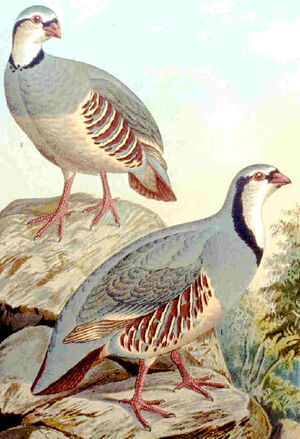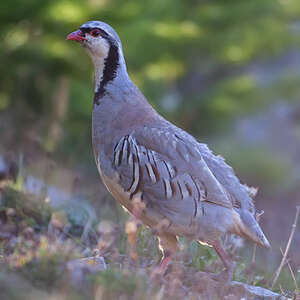Rock Partridge
Alectoris graeca - Perdrix bartavelle
Identification
The Rock Partridge has a greyish-brown back, light blue-grey chest, pale reddish belly and flanks striped with reddish, black and cream. Its bill and legs are red. It can be distinguished from the Red-legged Partridge by the white area of its throat which extends slightly up the chest and is surrounded by a clearly defined black collar with no speckles on the neck and by its flanks feathers which are marked by two black bands instead of one.
There is no distinct sexual dimorphism (the male has a slightly larger stature) which makes it difficult to distinguish between the cock and the hen, except by their behaviour in spring when the partridges are in pairs. The male can be distinguished by its tendency to often look out and frequently sing from a promontory.
Subspecific information 4 subspecies
- Alectoris graeca graeca (Serbia and Albania to Greece and Bulgaria)
- Alectoris graeca saxatilis (Alps from France to w Croatia)
- Alectoris graeca orlandoi (Italy)
- Alectoris graeca whitakeri (Sicily)
Foreign names
- Perdrix bartavelle,
- Perdiz griega,
- perdiz-grega,
- Steinhuhn,
- szirti fogoly,
- Steenpatrijs,
- Coturnice,
- stenhöna,
- Steinhøne,
- kuropta horská,
- orebice horská,
- Stenhøne,
- kivikkopyy,
- perdiu de roca,
- Steinhæna,
- góropatwa skalna,
- klinšu irbe,
- kotorna,
- Европейский кеклик,
- ハイイロイワシャコ,
- 欧石鸡,
- 歐石雞,
Voice song and call
The Rock Partridge has a shrill and high-pitched cry. Its rapid and repeated alarm call is also shrill, chitti-ti-tok...chitti-ti-tok... or chuk...chuk...chuk...pairchuk ...pairchuk pairchuk...chukara chukara. When it is worried, it is rather a sharp whistle pitchii followed by a whitouu-whitouu. It sings mostly at dawn and at twilight, a resonant, rhythmic and shrill song.
The Rock Partridge also brourit, cacabe, glousse, pirouitte and rappelle.
Habitat
The Rock Partridge can be found in both garrigues areas and various mountain environments that span from alpages to mountain peaks. It particularly likes south-facing slopes between 1500 and 2600 meters in altitude. Originally from the East, it still has a strong preference for warmth, well-exposed arid areas, boulder fields and rocky slopes as well as very steep slopes where the presence of tall grasses provides it both food and shelter. It sometimes frequents open woodland stands of larch, Swiss stone pine or European Stone Pine. In the summer, it can be found at altitudes above 3000 meters, but, poorly adapted to the cold, it must leave the peaks as soon as the first manifestations of winter arrive. That's when it can be found at altitudes below 1000 meters to look for food on steep slopes covered with heather and meadows, terraced crops, and even more wooded terrain; its presence in these places depends on the duration of snowfall at higher altitudes.
Behaviour character trait
The Rock Partridge is a gregarious bird which is rarely found alone and is most often encountered in groups which range from 2 to 12 individuals. It is an indefatigable runner which is able to climb steep scree slopes with ease and descends rocky slopes with surprising speed.
The species is mostly sedentary but climate fluctuations force it to make seasonal movements of a few kilometers.
Flight
Dietfeeding habits
The Rock Partridge's diet is mainly composed of vegetation (leaves, shoots, buds, seeds, berries) or invertebrates which are mostly consumed by chicks and hens during the breeding period (insects, spiders, centipedes, woodlice and molluscs).
From late August to November, the Rock Partridge tends to move upwards of the slopes to take advantage of plant regrowth and the development of orthopterans (main food source in the fall).
Reproduction nesting
During breeding, the Rock Partridge mainly occupies the subalpine and mountain layers, provided it is not forest. The Rock Partridge is a monogamous species. The nest is built on the ground, in a depression lined with grass. It is well hidden under cover of a shrub or among rocks. The environment must have an acute microrelief to provide the maximum protection. From mid-May, it lays between 8 and 14 eggs, cream with red spots (42 mm), which will hatch at the end of June to the beginning of August. Incubation by the female lasts 24 to 26 days. The chick, nidifugal, is black-brown with some light and darker traces. In case of danger the young ones disperse or take refuge under their mother's belly. Both parents take care of the young for three weeks, until their flight. It will take them 50 to 60 days to reach the size of the adults.
Geographic range
This species lives in Europe in the Alps and in Italy, and from the Balkans to Greece. In France it can be found in the seven Alpine departments (Haute-Savoie, Savoie, Isère, Drôme, Hautes-Alpes, Alpes de Haute-Provence, Alpes-Maritimes). Rock Partridge resides there.
Threats - protection
IUCN conservation status
concern
in the Wild
threatened
evaluated
In the 1950s and 1960s, a decrease in population was observed due to several factors. The first is agricultural decline which led to the closure of habitats mainly in low and middle altitudes. The second is the development of ridges for winter sports. Other factors also contribute to the reduction of habitats necessary for wintering and reproduction, such as the passage of large herds of domestic animals on its breeding grounds.
Between 2003 and 2007 the population was increasing in the French Alps, thanks to the implementation of a harvesting plan and the prohibition of releasing red partridge (Alectoris rufa) above 1000 meters altitude, which produced hybridization. In Sicily, the Rock Partridge is sometimes the victim of chemical herbicides.
The bird is listed in Annex II of the Bern Convention and the Birds Directive.
Sources of information
- IOC World Bird List (v15.1), Gill, F and D Donsker (Eds). 2025-12-07.
Other sources of interest
 Specification sheet created on
02/08/2023 by Jean-Pierre Trouillas
Specification sheet created on
02/08/2023 by Jean-Pierre TrouillasTranslation by AI Oiseaux.net
© 1996-2025 Oiseaux.net
- Accipitriformes
- Aegotheliformes
- Anseriformes
- Apodiformes
- Apterygiformes
- Bucerotiformes
- Caprimulgiformes
- Cariamiformes
- Casuariiformes
- Charadriiformes
- Ciconiiformes
- Coliiformes
- Columbiformes
- Coraciiformes
- Cuculiformes
- Eurypygiformes
- Falconiformes
- Galliformes
- Gaviiformes
- Gruiformes
- Leptosomiformes
- Mesitornithiformes
- Musophagiformes
- Nyctibiiformes
- Opisthocomiformes
- Otidiformes
- Passeriformes
- Pelecaniformes
- Phaethontiformes
- Phoenicopteriformes
- Piciformes
- Podargiformes
- Podicipediformes
- Procellariiformes
- Psittaciformes
- Pterocliformes
- Rheiformes
- Sphenisciformes
- Steatornithiformes
- Strigiformes
- Struthioniformes
- Suliformes
- Tinamiformes
- Trogoniformes













